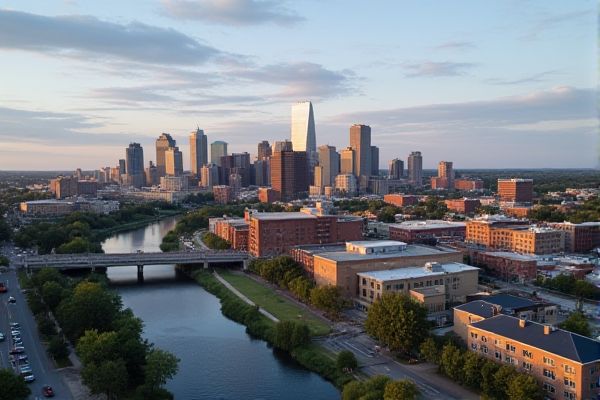
Transportation and commuting in Minnesota: Extensive Metro Transit bus and light rail system. Northstar commuter train for suburban access. Reliable ride-sharing options available throughout. Several park-and-ride facilities reduce traffic. Designated bike lanes and trails statewide. Minneapolis Skyway System connects downtown buildings. Carpool lanes on major highways encourage sharing. Winter driving requires experience and preparation. Ample electric vehicle charging stations available. MSP Airport offers global flight connections.
Extensive Metro Transit bus and light rail system.
Metro Transit in Minnesota operates an extensive network of buses, light rail, and commuter trains, including two light rail lines, Blue and Green Lines, and five bus rapid transit lines. This comprehensive system provides nearly 45 million rides across the Twin Cities region in 2023. Additionally, Metro Transit offers integrated services for carpooling, vanpooling, walking, and biking, ensuring convenient and diverse transportation options for residents and visitors alike.
Northstar commuter train for suburban access.
The Northstar Line is a commuter rail route in Minnesota, covering a distance of 40 miles from Big Lake to downtown Minneapolis at Target Field, utilizing existing BNSF Railway tracks. Since its inception in 2009, the service has been focused on offering weekday trips, with no services on the weekends. Recently, there have been noticeable increases in service levels, including special event services. Additionally, there are considerations for potential future extensions to St. Cloud and other regions, enhancing connectivity across the area. For more information on this commuter rail, visit the Northstar Line page on Wikipedia.
Reliable ride-sharing options available throughout.
In Minneapolis, reliable ride-sharing options include Uber and Lyft, which continue to operate due to new Minnesota state legislation that overrides local ordinances and ensures fair driver pay. Additionally, new companies such as Wridz and MyWheels have been licensed to operate in the area, providing alternative ride-sharing services.
Several park-and-ride facilities reduce traffic.
In Minnesota, Park-and-Ride facilities are ingeniously designed to tackle traffic congestion by encouraging the use of multioccupancy vehicles and public transit. These facilities not only aim to decrease low-occupancy vehicle miles but also work towards mitigating issues such as pollution, energy consumption, and highway wear and tear. By expanding the reach of transit services in low-density regions, they make public transit a viable competitor to automobile commuting in suburban settings, significantly boosting job accessibility for both suburban and exurban residents. The strategic placement of these facilities can effectively address parking shortages and reduce greenhouse gas emissions by offering commuters an opportunity to utilize public transportation for the most congested legs of their journeys, thereby reaching key destinations more efficiently. The efforts to enhance public transit accessibility and sustainability can be further explored by reading the detailed insights available in the Minnesota Statutes, which outlines the regulatory framework supporting these essential infrastructural developments.
Designated bike lanes and trails statewide.
Minnesota offers a diverse network of bike trails, including hundreds of miles of paved bike paths, over a thousand miles of natural surface trails, and singletrack trails, such as those in the Cuyuna Mountain Bike System, providing options for all skill levels and preferences. For more information on planning your biking adventure, visit the Minnesota Bike Trails page.
Minneapolis Skyway System connects downtown buildings.
The Minneapolis Skyway System stands as the largest contiguous network of enclosed, second-level bridges globally, seamlessly connecting over 80 city blocks and extending more than 9.5 miles. This impressive architecture links various downtown buildings, including corporate offices, restaurants, hotels, and sports facilities, offering a unique convenience. By allowing pedestrians to navigate in a climate-controlled environment throughout the year, the Skyway enhances accessibility and comfort. To explore more about its extensive layout and benefits, visit the Minneapolis Skyway Guide.
Carpool lanes on major highways encourage sharing.
In Minnesota, Carpool Lanes on major highways are designed to encourage ride-sharing by providing faster travel times, even during peak hours. These lanes, located on the far left of the freeways, are open to vehicles with two or more occupants. Additionally, single-occupant vehicles have the option to use them by paying a toll through the MnPass System. This initiative helps in reducing traffic congestion and promoting environmentally friendly travel options.
Winter driving requires experience and preparation.
Winter driving in Minnesota requires thorough vehicle preparation, including switching to winter tires, checking battery and fluid levels, and clearing snow and ice from the vehicle. Additionally, cautious driving habits such as slowing down, increasing following distance, and knowing how to recover from losing control on icy or snowy roads are essential. For more comprehensive guidelines, visit the Know Your Rights website, which offers invaluable tips to ensure safety during the challenging winter months.
Ample electric vehicle charging stations available.
Minnesota, particularly the Minneapolis-St. Paul-Bloomington area, has a robust network of electric vehicle charging stations, with a wide array of public charging stations, including numerous free stations and DC Fast Chargers, ensuring ample charging options for EV users.
MSP Airport offers global flight connections.
Minneapolis-Saint Paul International Airport (MSP) offers extensive global flight connections, with non-stop flights to 166 destinations in 21 countries, including 131 domestic destinations and several international routes, particularly to Europe and Canada. For further details on these flight options, visit Flight Connections for a comprehensive overview and up-to-date information on available routes.
